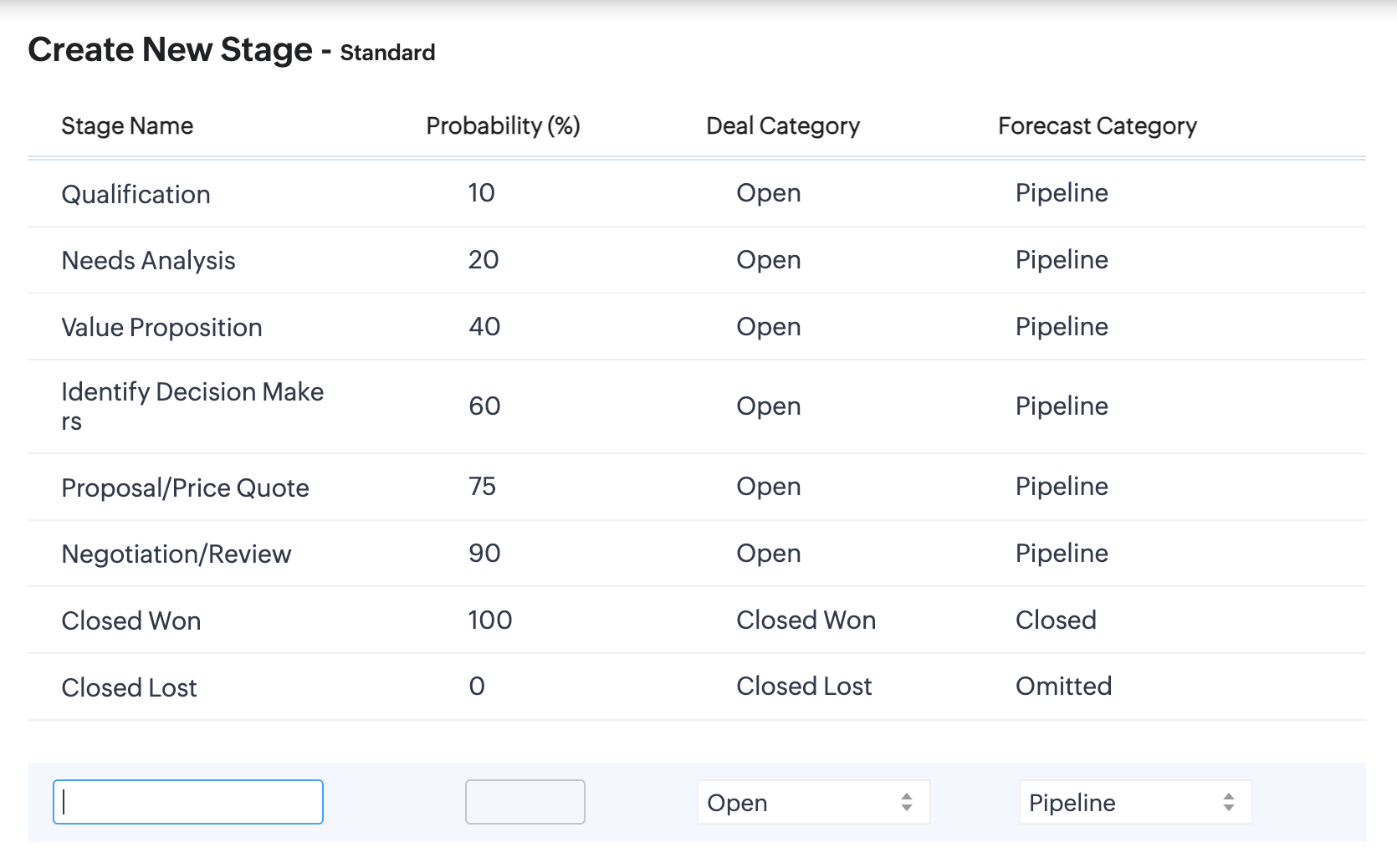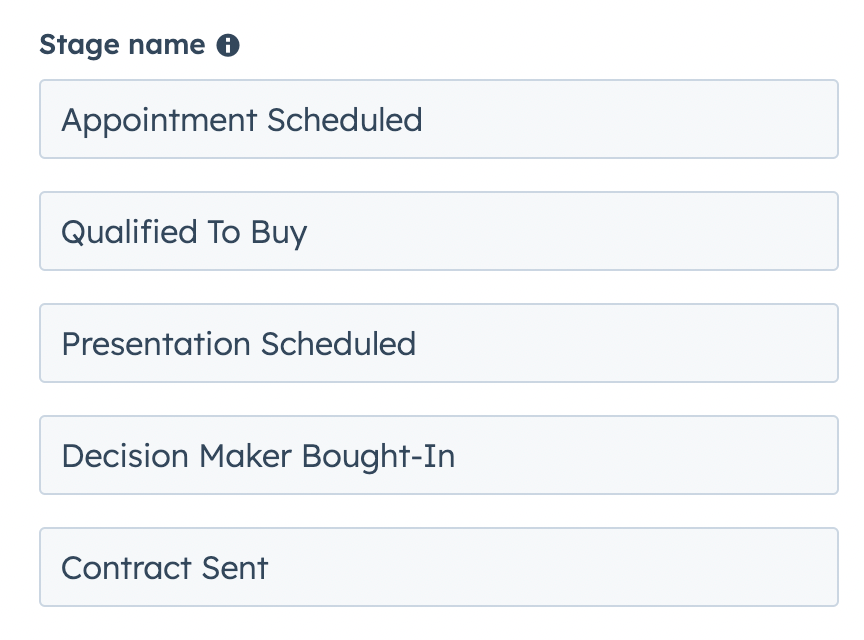What are B2B sales pipeline stages?
A B2B sales pipeline stage is a single milestone that a potential customer has to complete on their customer journey of buying your product or service. When properly done, a collection of sales pipeline stages (i.e. a collection of activities or processes) will take the customer from the initial stage i.e. awareness of your product or service, to eventually buying from you. In this article we will look to explore what is a sales pipeline stage, and give you ideas on how you can build your own sales pipeline stages.
A quick way to understand the different sales pipeline stages is to look at the top CRM software apps and see how they have built their default pipeline stages:
Zoho's default sales pipeline stages:
I like that Zoho has built a few custom defaults and also allows you to add your own sales pipeline stages. I also like how they have defined the probability for each stage. According to Zoho, each stage can either be open or closed. In Zoho, by default they have built this customer sales pipeline stage flow: Qualification -> Needs Analysis -> Value proposition -> Identifying decision makers -> Proposal price quotes -> Negotiations and reviews.

Salesforce's default sales pipeline stages:
Salesforce has done a good job on estimating what the sales process would look like: Qualification, Meet & Present, Propose, Negotiate and Closed stages. Again, like Zoho you can add your own custom stages if you want, and they have added the probability percentage for each stage which you can manually adjust. If you need help setting up your Salesforce CRM, this article looks at the important things: accounts, leads, contacts, opportunities, global actions.

Hubspots sales pipeline stages:
Hubspot allows you create an open or closed stage. For the open stages, the customer flows from Appointment Scheduled, to Qualified to Buy, to Presentation Scheduled, to Decision Maker Bought-In, to Contract Sent, to Closed.

Pipedrive sales pipeline stages:
Let's look at one more CRM app to see how they have built their sales pipeline stages. Pipedrive has these default stages: From qualified, to contact made, to demo scheduled, to proposal made, to negotiations started. You again have the opportunity to add your own custom stages.

Different stages in a B2B sales pipeline:
As you can see from the above examples, there are many different stages for your sales pipeline, and it should be unique to your business. The way you structure your sales pipeline totally depends on the customer you are selling to and the resources you have available. Sales pipelines are different for each industry, and can also be different for companies within the same industry. However, there are 5-7 stages which can help you build your own sales pipelines steps.
- Lead Generation: This is the stage where you identifying potential customers who might be interested in your product or service. This can be done in many different ways, depending on how you are targeting, and the channel you choose to target them. For example, if you were selling software to HR professionals, you could end up writing LinkedPosts, or displaying paid ads. If you were trying to target small business manufacturers, you could end up attending trade shows or industry conferences.
- Qualification: This is the stage where you evaluate if the lead has a genuine need for the product and the ability to purchase from you. You could do this by having an introductory call to gauge their interest. You can use different CRM tools to sort and score customers by interest, activity and engagement with you.
- Needs assessment: This is wher you understand the specific requirements and pain points of the prospect. You could do this by distributing surveys or questionnaires to the potential customers. The idea is to get more details and insights into the specific challenges they face, and to identify if your product or service can be a possible solution.
- Proposal / Presentation: This is where you present the solution tailored to the prospect's needs. You can use testimonials, case studies to increase your credibility.
- Negotiation: Discussing terms, conditions, and prices to arrive at a mutual agreement.
- Closing: This is the closing stage where you finalize the deal and obtaining a commitment from the prospect. Yo go over the next steps, the executables and timelines to ensure that the customer is fully aware of the process.
- Post-sale follow-up: This is to ensure that your customers are satisfied with your product and service, and exploring potential upsell or referral opportunities. You can implement a referral program and incentivise customers to refer you to their friends.
Best practices for building your own sales pipeline stages:
First start by identifying the big touchpoints that a potential customer has to go thru from the initial lead stage to the closing stage. Speak to your sales team to understand how the sales cycle currently works and involve them in building your sales piepeline stages. Because they are out there selling and speaking to your customers, they will have a good understanding on the different steps a customer has to go thru to close the sale.
If you run an existing business, you can start by putting your potential customers into different buckets depending on where they are in the sales cycle. This is where a CRM is really useful. You can create one stage for leads, one for quantification, one for negotiation - and work with your team to put different customer into different stages.
Once the details are in a CRM, you will be able to quickly view where each customer is in their journey, how much is pending, who is responsible for each customer and so on.
Conclusion:
The advantages of tracking customers via sales pipeline stages is that you immediately know the steps they have completed till date, how long it has taken, and what are the remaining steps to take to complete the sale.
The actually stages in your sales pipeline will depend on who you are selling to. For example, if you are a real estate agent selling residential property - your potential customer may go thru the following pipeline stages:
- Enquire about the property - this is when they show interest in your property.
- View the property - this is when you get in touch with them arrange a physical or virtual tour of the property
- Offer & negotiation - this is when they submit their official offer
- Mortgage & documentation - this is when you process their financial and legal documents
- Closing - this is the final stage when you hand over the property to the buyer
Or if you are selling B2B software to small businesses, you could have the following customer journey:
- Lead generation: Initial contact through events, webinars, or inbound marketing.
- Lead qualification: Identifying whether the lead has potential interest and budget.
- Product demo: Providing a detailed demonstration of the software.
- Proposal & negotiation: Sending a formal proposal and discussing terms.
- Closing: Finalizing the contract and onboarding the client.
You sales cycle is unique to you. Use the ideas gained from this article to build your own sales pipeline stages.